Japandi bathroom ideas : 11 ways to create a calming sanctuary
A relaxing Japandi bathroom is well within your reach with these easy ideas


Emily Smith
Calm and serene, a Japandi bathroom is somewhat of a sanctuary. Combining Eastern style with Western design, this modern bathroom provides a functional yet zen-like environment for all your daily needs.
Japandi style combines the cosiness of the Scandinavian trend hygge with the Japanese concept of wabi-sabi, the idea that slow living, contentment, and simplicity are key to a well-lived life.
Just like with Japandi kitchens, when it comes to Japandi bathroom ideas, it’s all about creating a sanctuary, a calm place to bathe and relax and take a moment for yourself.
It is also one of the best key interior design trends for bathrooms, as simple lines and functionality come together – essential elements for this room. We speak to bathroom designers and interior experts to explore the best ways to achieve a restorative Japandi bathroom with ease.
Japandi bathroom ideas: 11 ways to get the look
The Japandi trend fuses calm, neutral palettes with texture, simplistic lines, and natural materials, all of which come together to create a cosy environment that feels restful.
“Keep lighting low, colour palette neutral, design simple and woods and stones in a natural finish, and you are halfway there to creating your own Japandi bathroom oasis,” says Tracey Hague, director of online furniture store Where Saints Go.
1. Choose muted, calming shades for walls
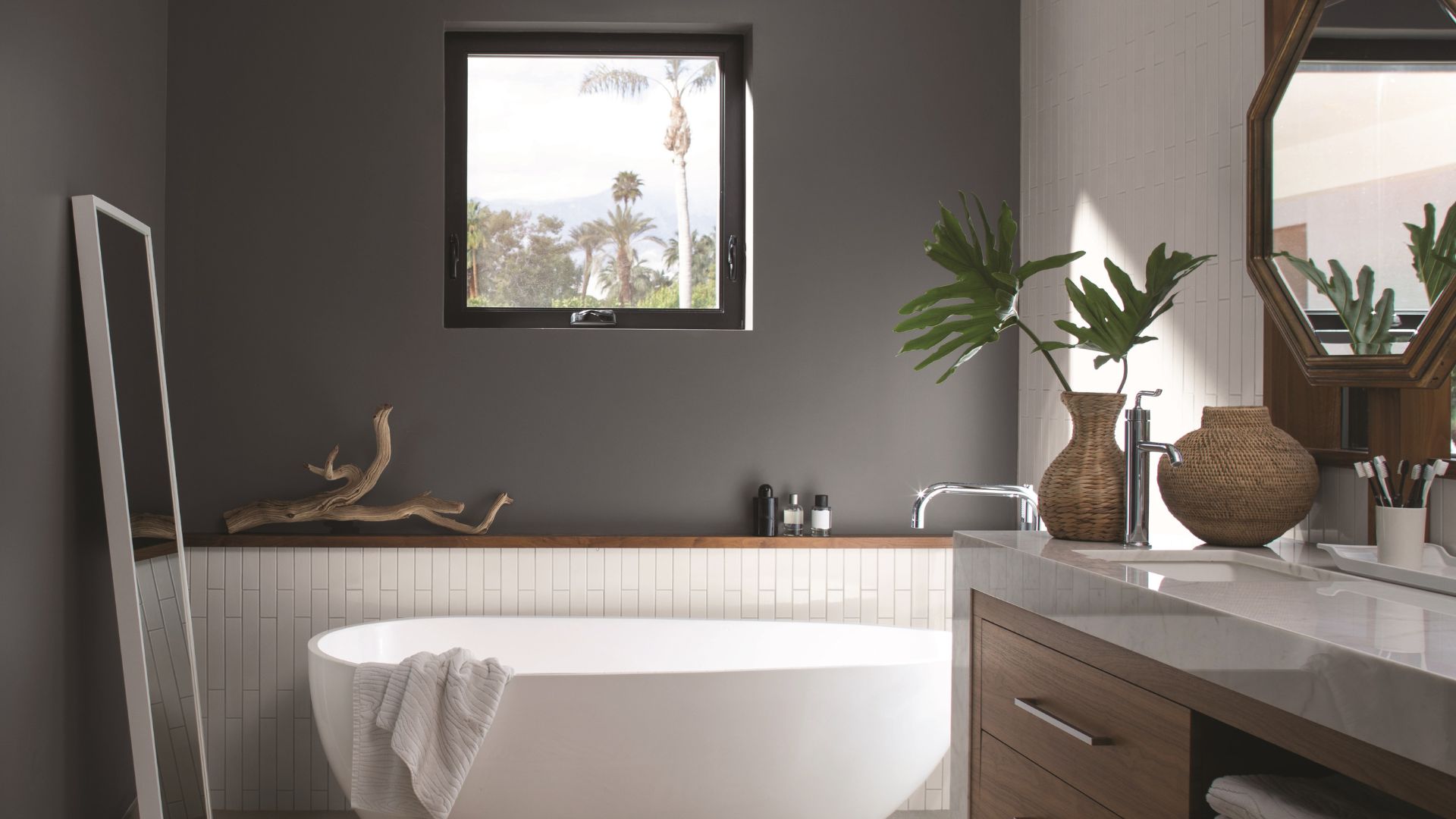
The Japandi colour palette is perfect for a bathroom as the colours are neutral, muted, and very calming. Be inspired by natural earthy hues, as well as more obvious neutral shades such as beige and taupe. Plants play an important role in this look, so splashes of calming pistachio green also work well and make for a comforting bathroom.
Sign up to our free daily email for the latest royal and entertainment news, interesting opinion, expert advice on styling and beauty trends, and no-nonsense guides to the health and wellness questions you want answered.
Aaron Markwell, COAT Paint's Colour Curator, says the right paint shades can help create a coordinated look. "Keeping to the same tones that you would pick for tiles and flooring in your wall colour is a great way to create a cohesive Japandi scheme,” he explains.
“Hay-like beiges such as our Moving Day shade, beige pastel-like greens, and soft, bright taupes are all fantastic for this. Pick out the woodwork in deeper brown colours for a reference to some of the darker woods that are used in traditional Japanese design, which will help your walls and tiling feel slightly brighter too."
The key to getting the right neutral look is by layering the shades, so you have contrast without going too dark, which would not be very Japandi! “Keep it neutral, layering similar shades onto one another to provide depth without ever actually going too dark,” advises Sophie Smith of Zhoosh Paints.
“Use natural light colours with warm, earthy undertones such as beige, green, and grey. Keep the palette subtle, as this look is all about neutral minimalism and clean comfort.”
2. Create a focal point with your bath
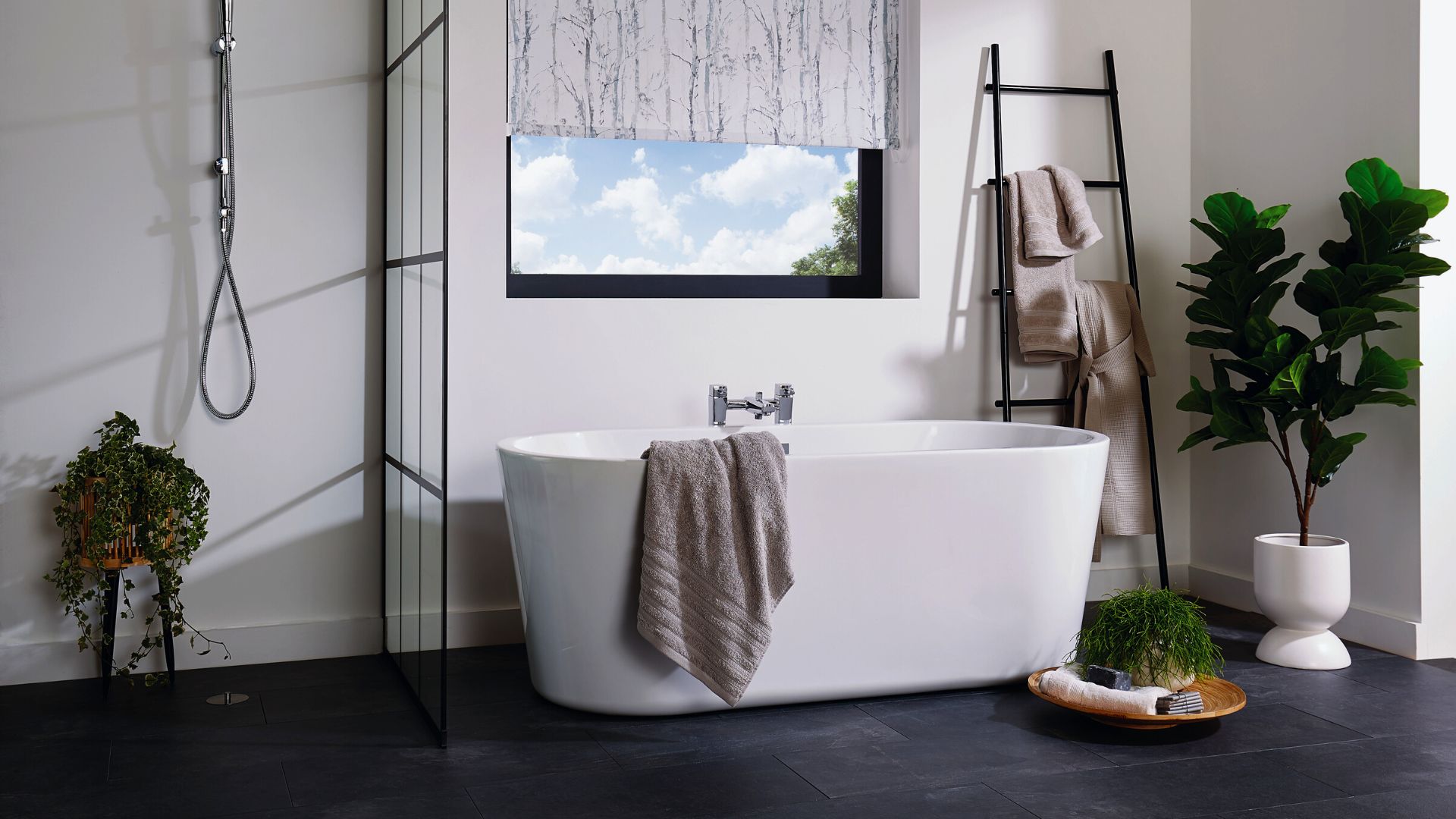
Bathing culture is huge in Japan, dating back to the 6th century. The custom was believed to not only wash the body but also cleanse the spirit and improve one's health. With this in mind, the bath being a focal point of any Japandi bathroom is key.
Whether it’s free-standing or set next to the wall, the bath should be the first thing you see when you enter the room. If your bathroom is smaller, the same goes for the shower. Make a statement with it by choosing black grid shower panels or a textured shower curtain.
3. Add warmth with textiles
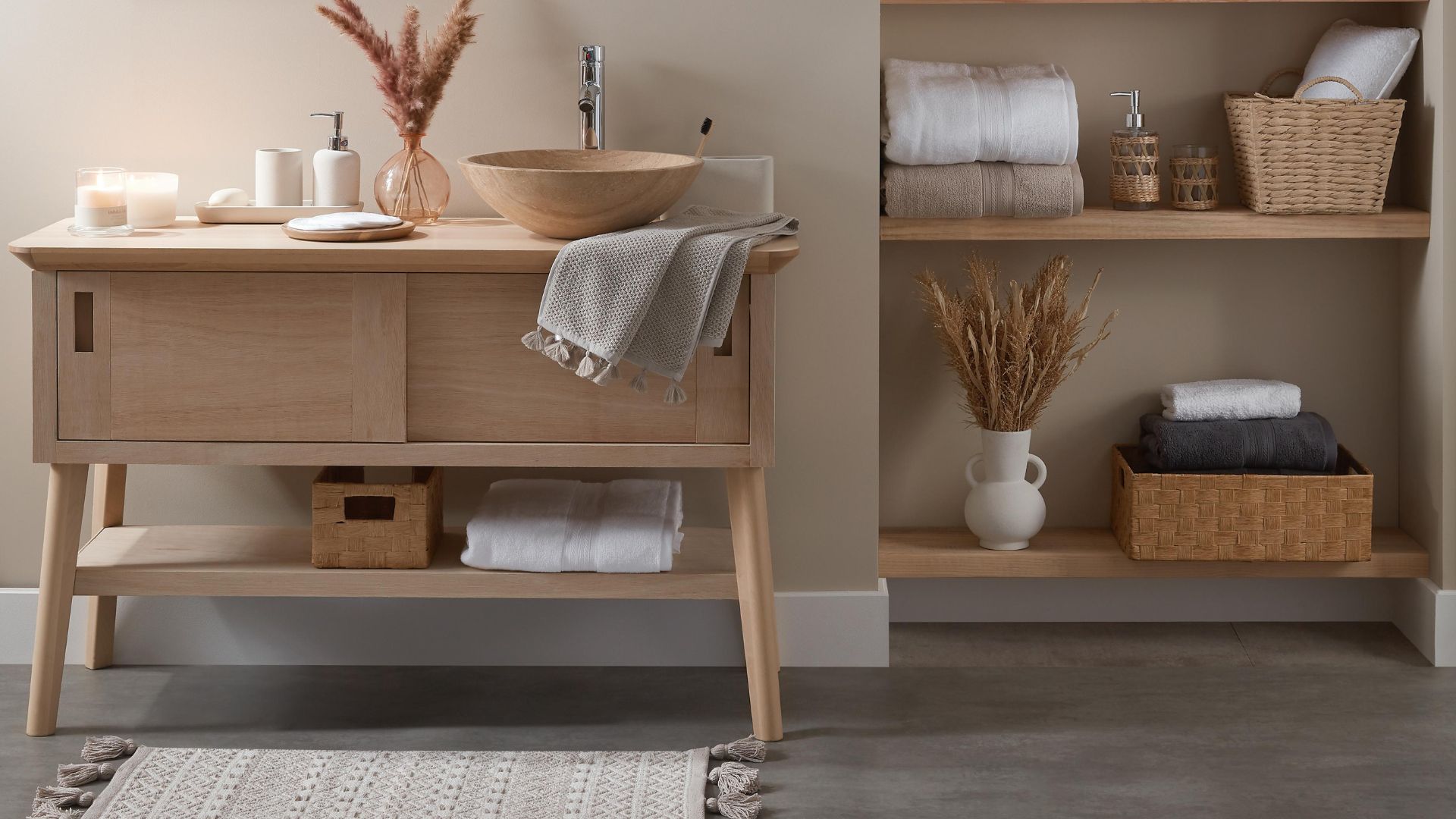
The Scandi side of Japandi is very much about being cosy, and one of the easiest ways to make a home feel cosy is to layer various textiles. In a bedroom or lounge, this can easily be done with the addition of throws and cushions, however, there are still ways to add a touch of warmth in bathrooms.
“Use different kinds of natural materials and textures in your bathroom – you can think about, for example, linen towels, a wooden bench, or a deep pile bathmat,” advises Laila. “Also, play with different shapes. Like, for example, an organic-shaped mirror.”
Choose the fluffiest, softest towels in muted shades to help ramp up the cosy factor. And don’t forget bathmats either. While you could go for a wooden one to ramp up the natural accessories, a great alternative is a tufted one made of organic cotton.
4. Keep design minimal and sleek
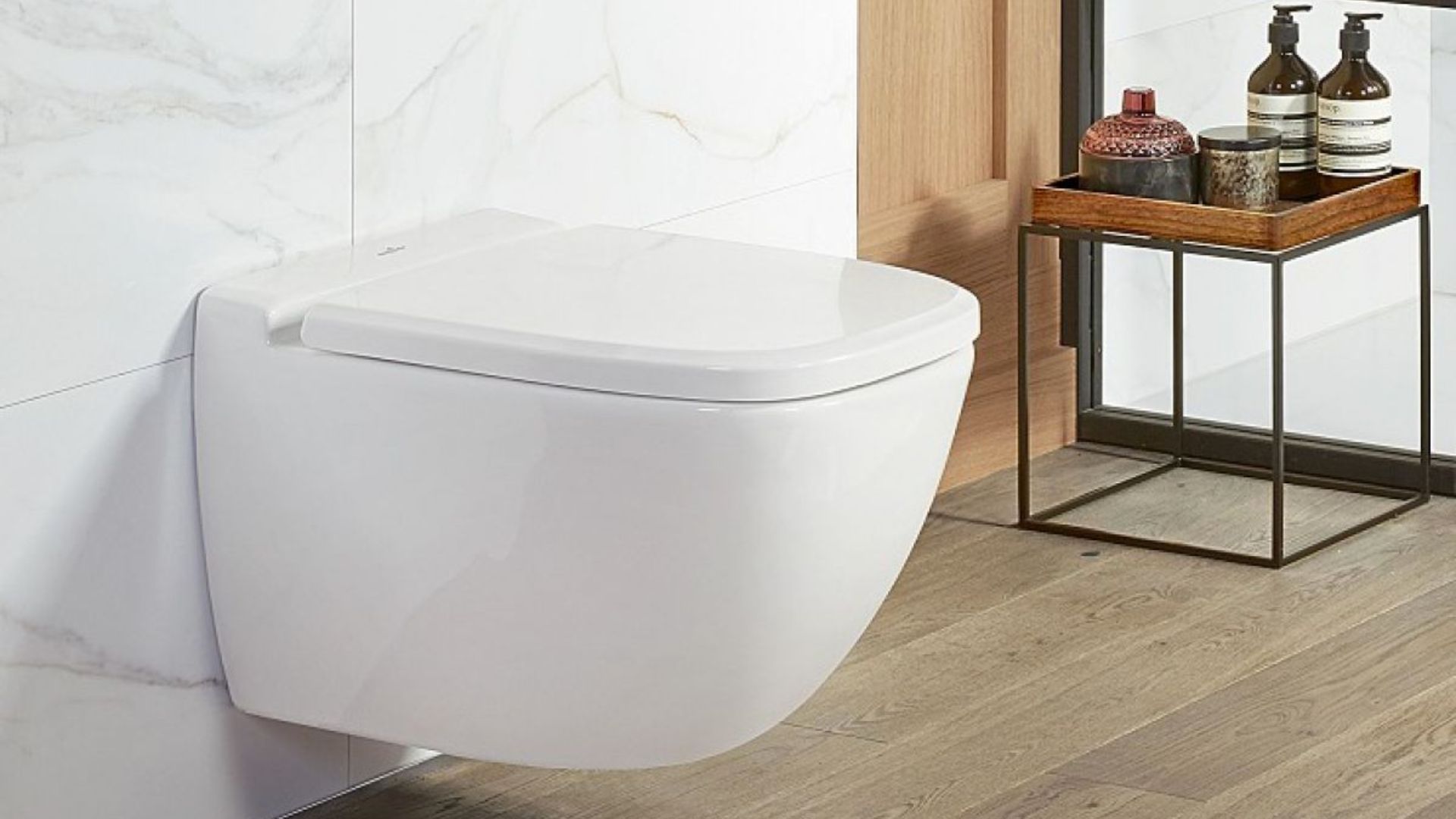
Pared-back bathroom suites create a feeling of tranquillity and calm, creating a spa-like feel. Do away with unnecessary handles. Choose a wall-mounted toilet to avoid a bathroom design mistake of the wrong fixtures and fittings. Keep sinks and baths sleek and simple in shape and design.
As with styling Japandi living rooms, keep accessories to a minimum. Too many bits and bobs can make the bathroom feel cluttered and chaotic, which is the opposite of the calm oasis you’re trying to create.
“Accessorise simply to achieve a natural, uncluttered appearance, and make sure you keep lotions and potions well hidden in beautiful cabinets," suggests Tracey.
5. Opt for functionality first
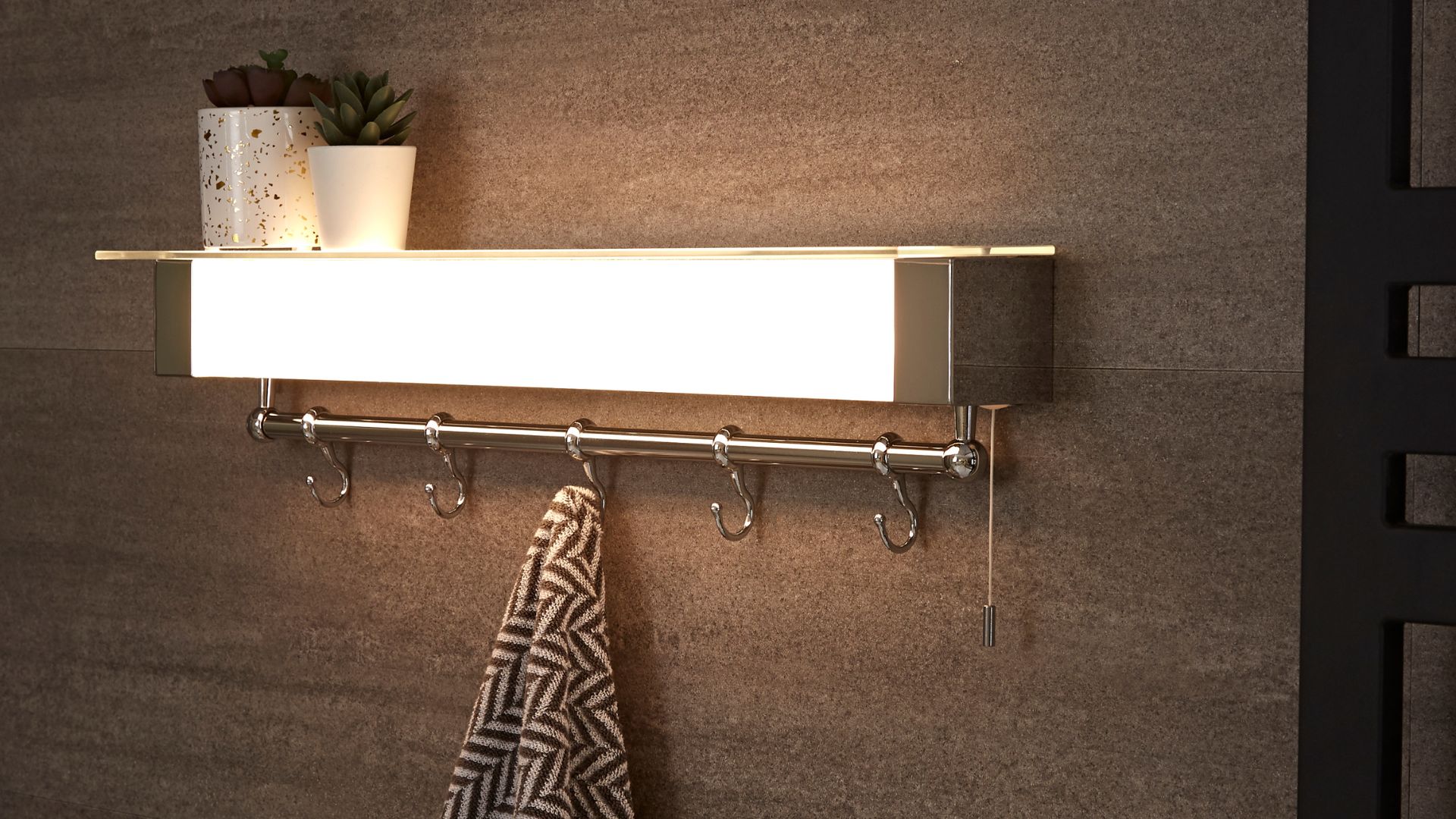
The minimal style is why functionality is so important. Storage is a major must-have for any Japandi bathroom. Bottles, jars, and tubes need to be kept behind closed doors to keep everything feeling zen-like.
Laila Rietbergen, the author of the interior design book Japandi Living and content creator at Japandi Interior, says that before you start installing storage, think about how much stuff you have and how much space you’ll need. A step-by-step decluttering afternoon might be in order as a result.
“You can then, for example, make a closet under your sink or a separate closet,” she says. “If you have a small bathroom, I would advise choosing a colour closet that blends into the wall behind it for that extra sleek look.”
The core of Japandi also states that everything needs to have a purpose. This is where functionality meets style. Choose a light that doubles up as a place to hang your towels or a mirror with a cupboard behind it. If it looks good and it’s practical, you’re onto a winner.
6. Play with texture

Textures are all important when it comes to Japandi bathroom ideas. The easiest way to inject this is via tiles. “Like the trend itself, the design calls for tiles that are simple and beautiful, calming yet invigorating,” says Abbas Youssefi, director of the independent tile retailer, Porcelain Superstore.
“Choose a tile with an architectural edge, which adds a statement design element that's simple and pared-back, yet pleasing to the eye. The gentle colour movement between tiles like these adds an element of wabi-sabi to the room, offering beauty in imperfection.”
Katie Seidler, interior designer and content creator at @hello_haus, agrees that floor and wall tiles are a super easy way to inject this much-needed texture, however, she says a lime wash can also work well.
"Natural stone finishes, neutral terrazzo or simple pale tiles will instantly add texture; however, if you don’t want to tile walls, a lime wash paint can add movement to the walls and a quick way to add texture in," she advises.
Alternatively, you can play around with wood, which not only adds to the Scandi feel but also brings the outdoors inside and helps add interest to the neutral colourway used in the room. One way to do this is with the use of cladding, says Tracey.
“Think light wood cladding and wooden furniture units mixed with stone or granite tops,” she suggests. “If money is tight, this look can be achieved cheaply with a little personal DIY skill. Numerous videos are available online instructing how to clad a wall effectively. Just ensure that you choose a nice light wood to create the correct look.”
7. Create a sanctuary with low level lights
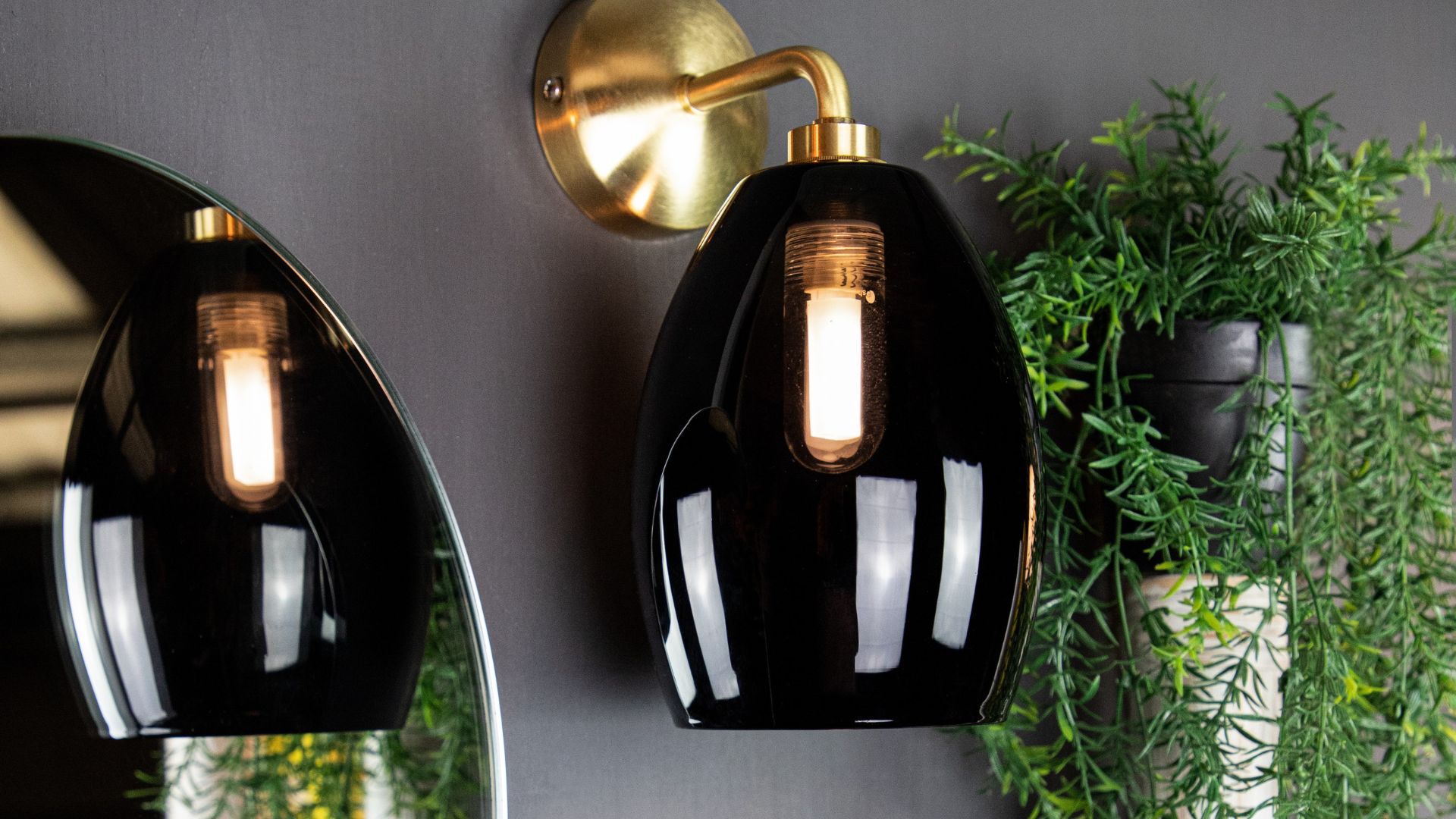
This is no ordinary bathroom, this is one to encourage self-care and a place of calm. The easiest way to create a sanctuary like this is with low-level light colour temperatures to create ambience.
Laila advises creating a layered lighting scheme by choosing something other than the usual spotlights and using dimmable lights if possible. That way, once the kids have been bathed, you can dim the lights and pretend you’re in that much-needed spa!
You can also affect the lighting mood by choosing lights with unusual glass coverings, or textured lampshades made out of natural elements such as wicker. Wall lights are also a nice touch as these create a softer, more chilled-out light.
As form and function are so important in a Japandi bathroom, lighting can also play into this. "We need our bathroom lighting to do its job and be practical, but you can choose back-lit mirrors that have a warm or cool light option," suggests Katie.
"These mirrors are perfect for flexibility. When it’s time to have a relaxing bath, you can switch the lighting from bright to warm and create a more relaxing space. Candles are also a great option to add to the ambience in here, so be sure to add these into a Japandi scheme."
The best flameless candles and best-scented candles are a fabulous way to add ambient light while you bathe.

RRP: £29.99 set of 3 | This trio of candles is the perfect way to create a warming ambience in your bathroom without worrying about an open flame. Plus, they're rechargeable, so you don't have to worry about buying candles constantly.
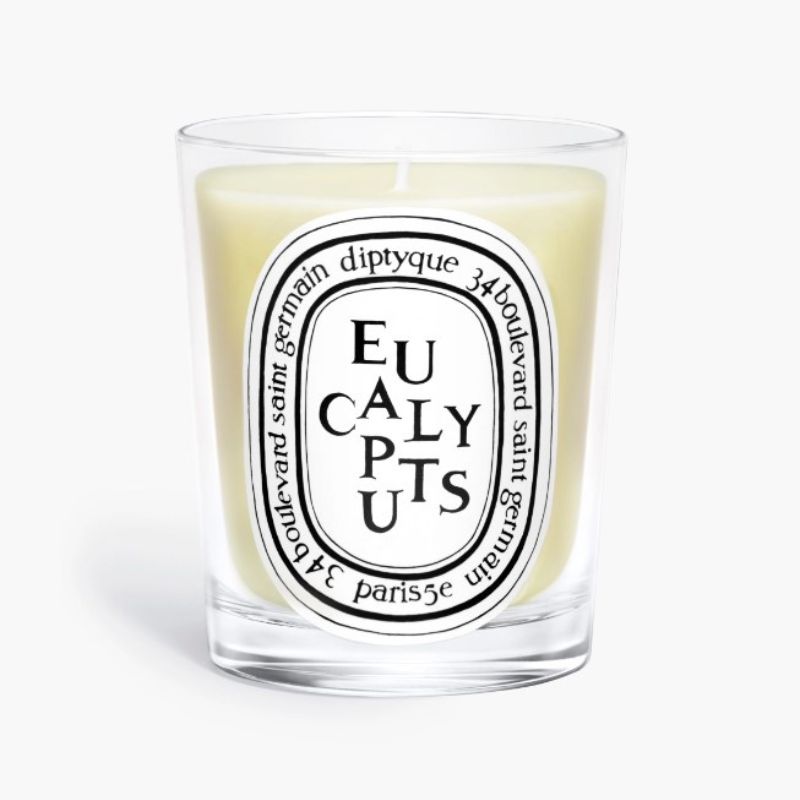
RRP: £58 | As the pros of creating scented candles, Diptyque can be trusted to deliver the highest quality scents, and this calming eucalyptus candle is no exception.

RRP: was £55 now £38.50 | If you're looking for a scent that will bring a moment of calm to your bathing session, then look no further than this 3-wick candle from Neom.
8. Pick natural accessories
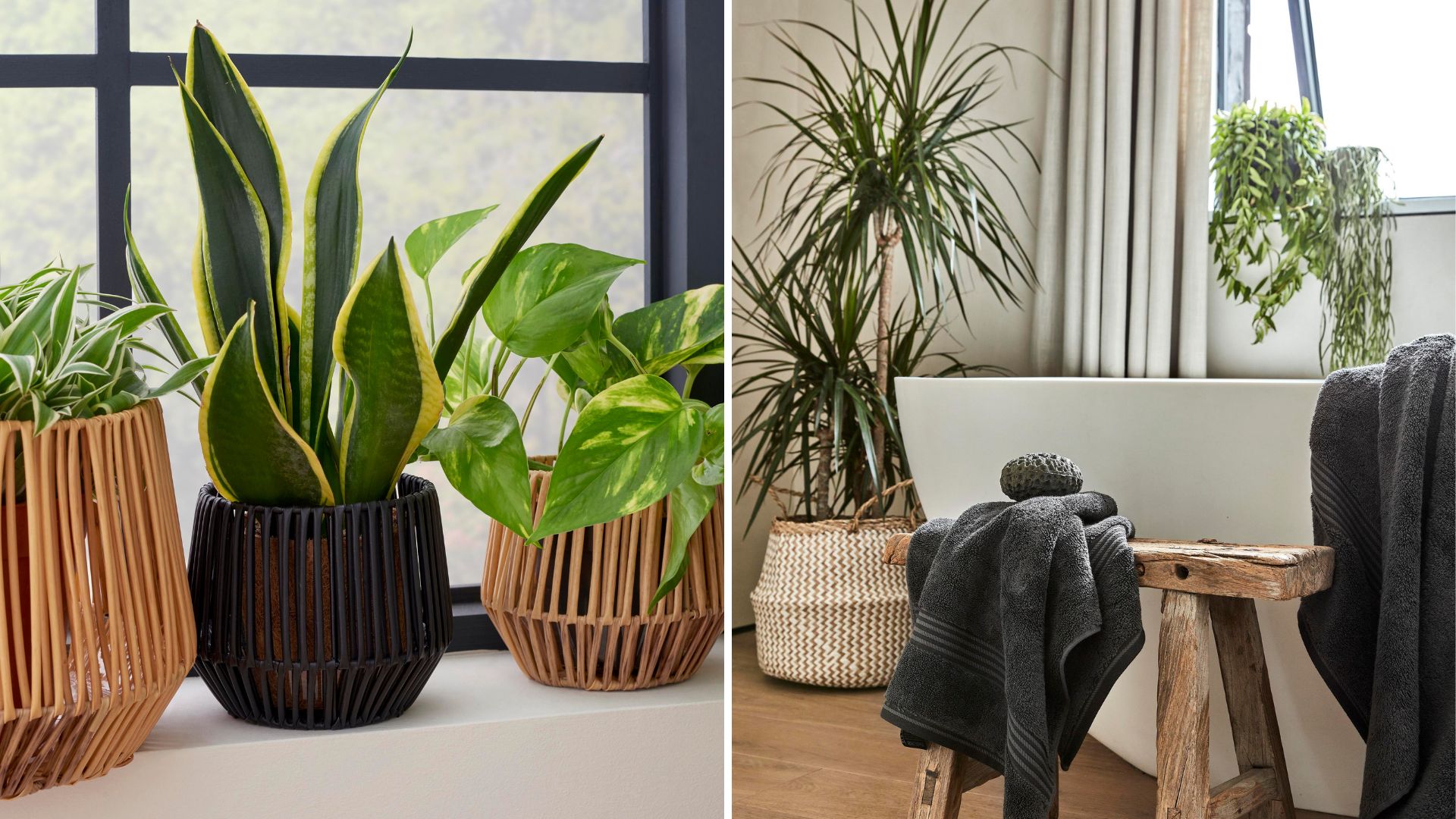
At the core of the Japandi style is the idea of bringing the outdoors inside. Plants not only help do this but also provide a contrast to the neutral shades.
“Accent colours should not be provided solely by the interior paint colour," advises Sophie. "Instead, use plants and natural materials such as stone and wood to provide a darker contrast and texture. These nods to the living world will complement your simple backdrop and help create a meditative space in which you can truly relax and unwind.”
You may not be used to having plants in your bathroom, but they’re a great addition as by release oxygen and absorb carbon dioxide, they freshen up the air and eliminate any toxins - a great way to improve the air quality of your home. Scientific studies have also shown that houseplants help to relieve stress.
As bathrooms can often have mixed temperatures, it’s best to choose a hearty plant such as a bird’s nest fern or aloe vera. If your bathroom doesn’t have much natural light, choose a spider plant or pothos that can survive in dim light.
If you’re not green-fingered and don’t fancy artificial plants, you can still get the feeling of Japandi into your bathroom by using natural accessories such as a rattan laundry basket, a bamboo toothbrush holder, or a wooden storage caddy.
9. Add black accents
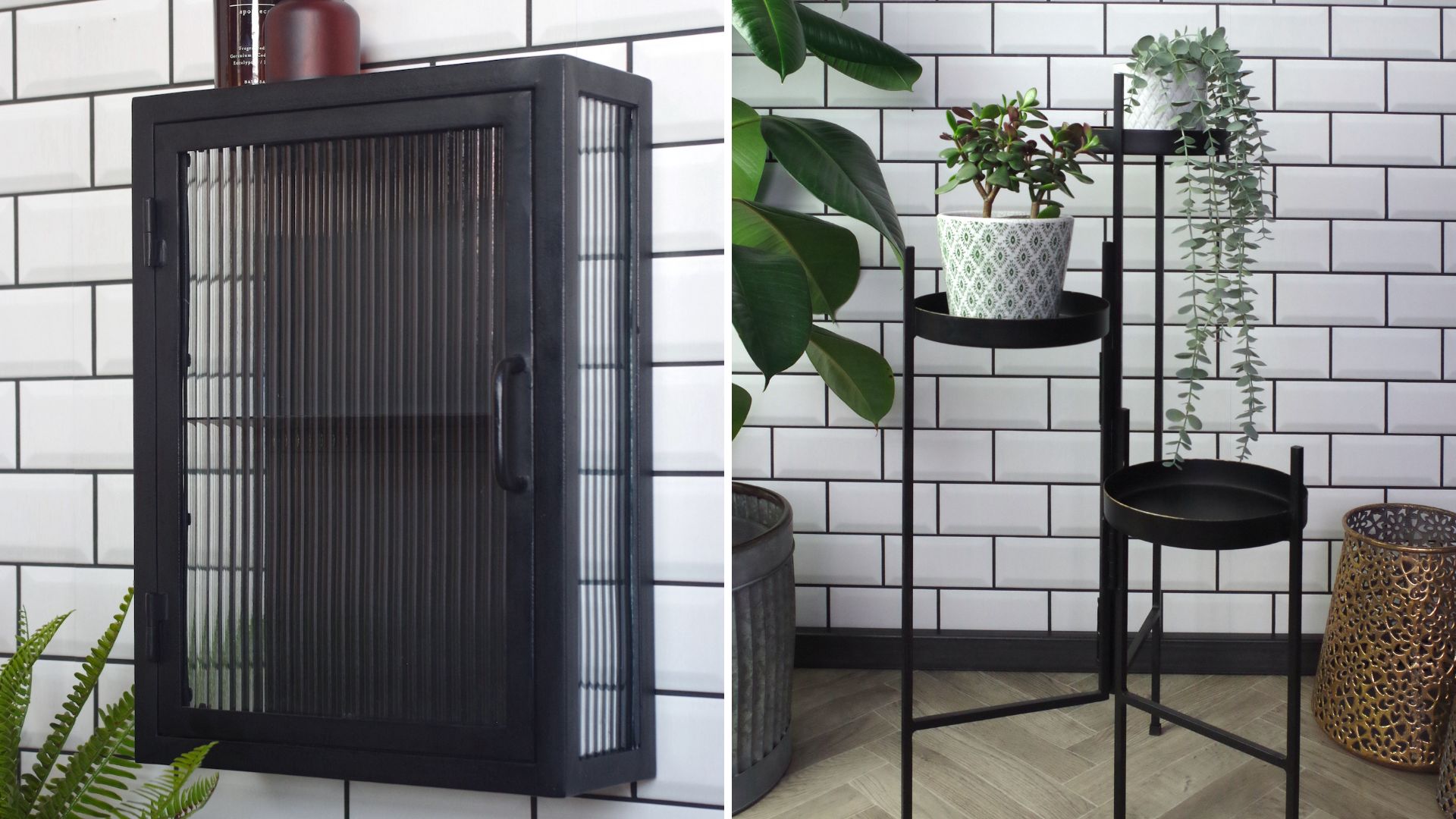
Accents of matt black are not only very Japanese in feel but bring together layers of neutral shades. Balancing the muted colours with elements of black throughout the bathroom, whether that be taps or textiles, such as bath mats and the best bath towels, helps create a calming atmosphere.
It also brings depth to the look, which could otherwise feel a tad washed out and flat with only neutral shades, with no real definition.
10. Think natural when it comes flooring

While tiles work with this trend, especially if they’re in muted earth shades or have some texture on them, the real hero of a Japandi bathroom is a wooden floor. The best way to achieve this in a bathroom is with vinyl flooring.
“Tile effect vinyl flooring is a perfect solution for creating this look in the bathroom, both aesthetically and practically,” says Punam Chada, a buyer for Carpetright Carpet.
“Offering a realistic finish, vinyl comes in a variety of styles, plus it’s affordable, easy to maintain, and highly durable. Vinyl products boast water and slip-resistant qualities, making them a great solution for a showroom or bathroom.”
If you want the real thing, choose hardwood, which can withstand moisture and humidity better than softwood. It will require more maintenance than tiles or laminate, though, as you’ll have to regularly reapply the lacquer that seals the wood to ensure no moisture gets in.
It's a good idea to know how to mix wood tones, so your fixtures and fittings look good next to your wooden floor.
11. Seek to be sustainable
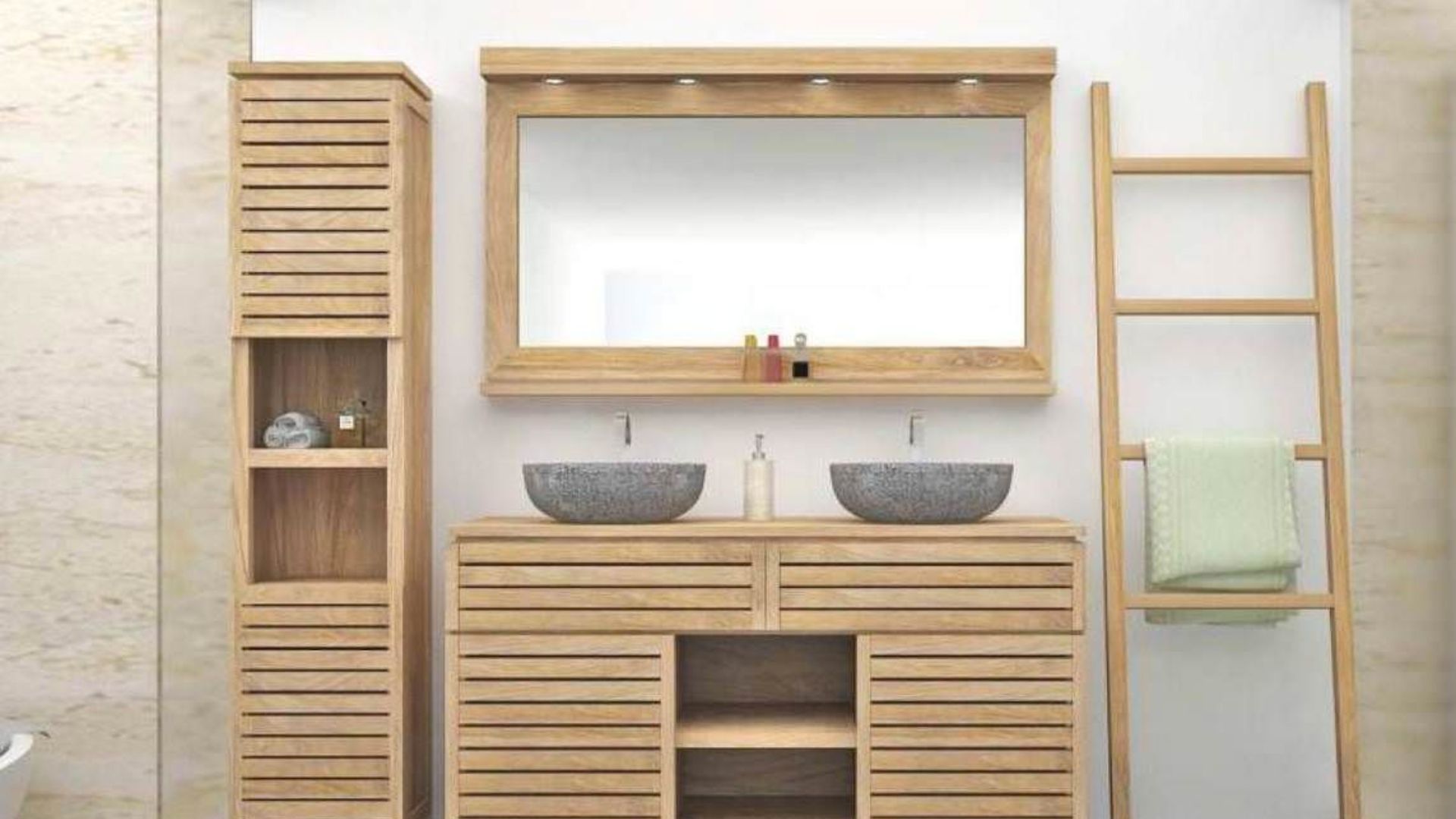
Sustainability is key to this trend. This is not about buying throwaway items that will be replaced a couple of years down the line, so it encourages more sustainable living choices for your home. Japandi is all about high-quality craftsmanship pieces that are timeless in style. If you can also use sustainable materials, such as copper, bamboo, and natural stone, even better.
“For an instant Japandi look that doesn’t cost the earth, accessorize your bathroom with bamboo,” suggests Sofia Charalambous, sales and marketing Director at Origins Living.
She continues: “This sustainable fast-growing reed is the perfect material to introduce into your bathing haven, inducing a calming and soothing feel. From bamboo framed mirrors and small storage containers to waffle towels, create a spa-style retreat, that is synonymous with Japanese and Scandinavian aesthetics.”
Also, think about reducing your water waste by choosing low-flow or water-saving shower heads that give the feeling of high pressure, without using as much water. Other ideas to conserve water include checking your taps and toilet for leaks and also turning off the tap while brushing your teeth.
FAQs
What is Japandi bathroom style?
While at the heart of this trend is an east-meets-west vibe, it’s very much open to personal interpretation, so what exactly is Japandi bathroom style?
For Katie, it's all about creating a warm, comforting environment that's connected very much to nature. "A Japandi style bathroom is a warm, textured-filled space with interesting finishes in neutral tones," she says.
"Think lime-washed walls with natural wood fixtures and accessories. Walls and ceilings feel connected in the same colour with no harsh lines or edges to separate them. Nature is key for this trend too, so a few long stems in an organic-shaped vase or plants would feature in a Japandi bathroom."
As Japandi promotes a zen-like feeling, Sophie believes it’s a natural match for spaces like bathrooms, with colour playing a vital role.
"The Japandi aesthetic brings together Japanese minimalism and Scandinavian cosy - and the aim is to encourage calm, serene living,” she says. “Bathrooms are all about relaxing anyway, so the colours you choose for your Japandi bathroom are very important, along with your accessories.”
A Japandi bathroom is more than just a design ethos, though. Tracy believes it’s also very much tied to wellness and self-care. “When I think of Japandi bathroom style, I think of de-stressing and relaxing after a hard day at the office – or escaping from the family”, she says.
What is a Japanese-style bathroom?

Although Japandi is one of the most popular bathroom trends, you may be wondering what the differences and similarities are between this and a traditional Japanese-style bathroom.
"A Japanese-style bathroom has many common elements with Japandi, but subtle differences that make it distinct. For example, Japanese design may incorporate darker wood, compared to the lighter tones of Japandi," says Mike Whitefield, luxury interiors expert at LUSSO.
"The core principles, however, remain the same. A minimalist aesthetic, emphasising harmony with nature to create a serene spa-like atmosphere in the bathroom," he continues.
How can you create a more zen bathroom?
If you want your bathroom to be a restful haven, there are some bathroom design rules you can follow to achieve this.
"To create a more zen bathroom, focus on fostering a sense of tranquillity and mindfulness. Use a restrained colour palette and natural textures to evoke a spa-like feel. Keep surfaces clear and storage concealed to reduce visual clutter. Incorporate elements like a deep soaking tub, a rainfall shower, or a bench for meditation," suggests Victoria.
She also recommends adding touches of nature with small plants, a bowl of decorative stones or a bamboo bath stool.
"Soft, indirect lighting and perhaps even the gentle sound of water can further enhance the ambience. Ultimately, a zen bathroom is about creating a sanctuary where you can unwind and reconnect with yourself, drawing on the timeless principles of Japandi and Japanese design," adds Victoria.
If you're not quite ready for a whole renovation, why not try out some tips for making your bathroom look expensive on a budget? Even some of the smallest changes can make a huge difference to the overall look and feel of your bathroom.
With over 25 years’ experience in journalism, Jayne has written about a variety of subjects. She spent the start of her career within the world of film, interviewing Hollywood stars, attending premieres and lusting after red carpet outfits, and then moved into fashion, launching websites for big magazines such as Look, Woman’s Own and Wedding and working with top fashion brands such as Westfield, LK Bennett and Hunter.
Career highlights include dressing up as Kylie (in gold hot pants!) for a national newspaper and working on big fashion events alongside Giles Deacon, Henry Holland and Naomi Campbell.
- Emily SmithDigital lifestyle writer
